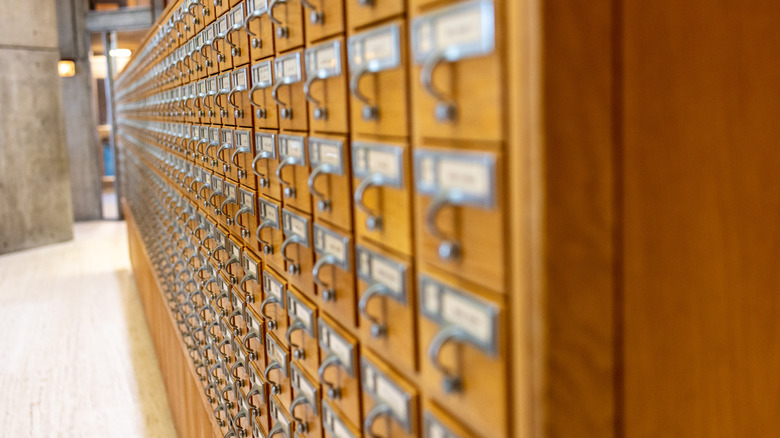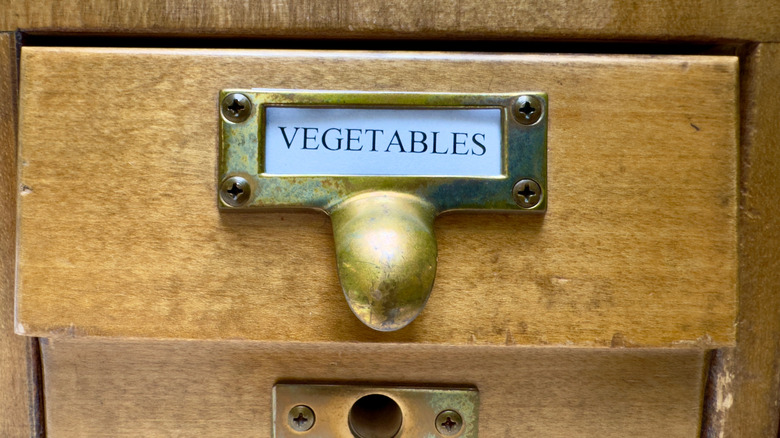This Vintage Thrift Find Is The Ultimate Storage Solution For Seed Organization
You're scouring your favorite shops for thrift store finds you can transform into beautiful garden decor when you spot it: A vintage card catalog, just like the one you flipped through as a child. Not only does it look beautiful, but it's full of storage. The problem is that the drawers on an average card catalog are small — they're designed to hold cards that measure either 2 inches by 5 inches or 3 inches by 5 inches. For gardeners, the choice is obvious: you can use that vintage card catalog for seed storage.
It's not a new concept. Many public libraries host one of the over 500 seed libraries worldwide and often dust off those old card catalogs to hold the packets. The drawers are an ideal size for seed packets. Card catalog setups also make organization easy. Each drawer can hold different types of seeds, and you can use dividers within each drawer for further categorization. Repurposing a card catalog into seed storage also adds a conversation piece to your home and keeps your seeds out of sight using a unique piece of furniture.
Preparing a vintage card catalog for seeds
Your thrifted card catalog may need some work before you use it as a clever way to store the seeds you collect from your garden. Check the hardware on each drawer, which includes the drawer pull and label holder. You may need to tighten the screws that secure the hardware. The wood might also need to be refinished, especially if you plan to display the seed storage card catalog inside your home.
If you think back to your early library days, you might recall the rod that runs down most card catalog drawers to hold cards in place. Removing the rod gives you a little extra storage room. There are different types of rods, including the friction-fit rod, which has a special tool to release it. Threaded rods need to be unscrewed to release. The lift-and-pull style requires you to lift up the visible knob on the front of the drawer while you pull it out. Some card catalog drawers have buttons, tabs, or other releases just inside the door that need to be pressed. However, you may want to keep the rod in place if you want to hole-punch dividers and thread them on the rod to help with organization.
To store garden seeds to keep them fresh, you'll want to place the card catalog in a dry, cool location. Adding silica-gel desiccant in each drawer helps control humidity. Avoid areas with direct sunlight and high temperatures as this can hurt the viability of stored seeds. Garages and sheds often become too humid and hot in the summer, so an indoor spot is ideal.
How to store seeds in a card catalog
You can keep the seeds in their original packets if you buy them from the store. For seeds you collect in your garden, you can purchase brown kraft seed packets or glassine packets. Label the packets with the plant name and other relevant information, such as the date collected or the growing season.
Organizing the varieties logically is a simple storage tip that'll help keep track of all the seeds you have. Even small card catalogs have multiple drawers, giving you plenty of space to organize and sort your seeds. Options include categorizing by plant name, family, growing season, and type of plant. Within each of those categories, you can sort in more ways. For example, you might sort your seeds by type of plant, such as annual, perennial, shrubs, and vines. Then, you might sort the seeds alphabetically based on the plant name within each of those subcategories.
Consider arranging multiple packets of the same type of seed based on the age. Say you save your own tomato seeds and package each year's seeds in a new envelope. Place the newest year's seeds in the back of your tomato section. Seeds have a limited shelf life, so you want to use the oldest seeds first. How long seeds last depends on the variety of plant. For example, lettuce, parsley, onion, and corn seeds typically only last about 2 years while cucumber, brussels sprouts, radish, and endive seeds could last 5 years. Writing the date that you purchase or collect the seeds helps you track the age and use seeds while they're still viable.


